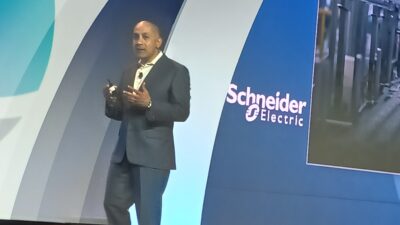Growing evidence confirms that information technology use in manufacturing operations is at an inflection point that AMR Research refers to as Manufacturing 2.0. The changing operations landscape was the subject of considerable discussion at the recent Manufacturing Enterprise Solutions Association (MESA) International Conference.
Growing evidence confirms that information technology (IT) use in manufacturing operations is at an inflection point that Boston-based AMR Research refers to as Manufacturing 2.0.
The changing operations landscape was the subject of considerable discussion at the recent Manufacturing Enterprise Solutions Association (MESA) International Conference. The group—which includes users from discrete and process production industries, hardware and software suppliers, and consultants—promotes improvement of production operations through optimized application of IT and best practices.
More than a few of the MESA event speakers referred to the importance of achieving process flexibility on plant floors by applying Manufacturing 2.0-type emerging technologies—such as service-oriented architecture (SOA)—for an innovative and sustainable competitive advantage.
“A new model for manufacturing is emerging. Synchronized processes and systems make it possible to collaborate along the length and breadth of a value network, giving those participating an opportunity to attain first-mover advantage,” said Matt Bauer, MESA chairman, in the conference’s opening address.
| “The great innovation wars will be about process-based competition.”
—Peter Fingar, executive partner, Greystone Group |
Peter Fingar, an author and executive partner with Tampa-based Greystone Group , said in his keynote address, “Your product’s uniqueness is no longer the key. It’s your processes! The great innovation wars will be about process-based competition. If you’re going to compete, you have to make deep structural changes in how you do what you do.”
To further understand the current state of plant integration and computerization, MESA released the results of its Metrics for Major Initiatives survey, conducted by Cummaquid, Mass.-based Industry Directions , which looks at lean, total quality, and real-time information initiatives.
While the results may not be earth-shattering to industry veterans, they do indicate users share basic common management concepts, IT infrastructures, and product technology solutions, including use of both enterprise and execution systems.
A natural extension
In announcing its Manufacturing 2.0 initiative, AMR Research said it was a natural extension of its more than 20-year heritage, which includes coining the term manufacturing execution system (MES) in 1990. AMR also referred to it as a “more collaborative” model for demand-driven manufacturing than any of its previous ones.
Manufacturers need better collaboration for material sourcing, quality, process and product design, and production planning, says AMR.
| “[Manufacturers] need to capitalize on broad vendor adoption of manufacturing SOA.”
—Colin Masson, director, AMR Research |
“It’s time to break the shackles of ERP and MES application models and let users address the manufacturing systems backlog,” says Colin Masson, a director with AMR. “They need to capitalize on broad vendor adoption of manufacturing SOA architectures and apply emerging Web 2.0 and Enterprise 2.0 patterns.”
The change under way at Boeing is fundamental, says Roy Brower, system analyst and project engineer for Boeing’s MES implementation. Brower believes Boeing has the largest production information system in the world, with 35,000 global users.
“The big paradigm shift has been from running our company with a cruise ship mentality where everybody was headed to the same port, but each individual in his cabin was doing his own thing, to a battleship mentality where everybody onboard has a battle station. We’ll sacrifice our own small battles to win the bigger war,” says Brower.
And in the wake of the turnaround he engineered at UPCO , a Claremore, Okla.-based manufacturer of oil-field products, William Ridenour says the shift toward process-centric thinking must reach the organization’s highest levels.
When Ridenour rose from CFO to president of the company in 2000—following the oil industry bust in 1998—he shook things up by having management team members “shift one chair to the left” at the conference table, surrendering their own fiefdoms to take on oversight of another for six months.
“It gave us new perspectives on our peers’ jobs. We also realized we needed to communicate much better with one another,” he says.
More critically, it underscored the importance of an enterprise perspective over individual functions. “If you were a strong contributor but couldn’t adapt to working as a team, you had to leave,” adds Ridenour. “We ended up replacing most of our entire manufacturing management team at UPCO.”
Technology’s evolution
Of course, as Fingar noted in his MESA conference address, issues related to process innovation tend to come to the fore just when opportunities for process change are greatest.
“The invention of the potter’s wheel radically changed the process of making pots,” he says. More recent examples of process centricity include usage of the term business process engineering , which was prevalent in the 1990s when dealing with that period’s rapid technological change—especially the introduction of enterprise or ERP systems.
What’s different in more recent discussions is an emphasis away from one-time, potentially disruptive “big bang” approaches to process change. Instead, experts speak of systemic behavior that lets a company “compete at the speed of business change” by constantly monitoring and modifying processes.
The sources of complexity are changing as well. In addition to being more demand-driven, today’s supply chains are extended by many thousands of miles. Globalization, outsourcing, and offshoring expand the process horizon of most enterprises. According to Fingar, the average value chain today comprises 22 companies.
| “IT is beginning to realize there is a next step.”
—Julie Fraser, principal, |
“Five years ago, only electronics manufacturers were outsourcing,” says Julie Fraser, principal with Industry Directions , a research firm working with MESA to articulate the shift toward strategic process/IT alignment. “Today, everyone operates in the realm of the networked enterprise, working with suppliers and the suppliers of suppliers. In extending processes to include partners outside your four walls, tight control over the entire process can be lost.”
Ironically, the first challenge can be that companies struggle to define process and product specifications prior to sharing them with others.
After that, says Fraser, strong system linkages that support end-to-end processes are needed. That’s what’s behind the emphasis on an integrated, process-centric approach. “IT is beginning to realize that there is a next step,” she says.
The step into SOA
“SOA is a major paradigm shift,” says Eyad Buhulaiga, systems integration engineer for Arabian oil company Saudi Aramco, and lead for its enterprise-SOA project. “For the first time, the business will be driving IT—not the other way around. With SOA you flexibly assemble services any way you want, adding new blocks or combining them to do something that helps your business grow.”
This is driving software vendors to adopt SOA to quickly and easily create component applications—or services—that support critical processes. More strategically, companies may be able to configure quickly new processes that take advantage of dynamic market opportunities.
While AMR’s Masson concedes that MES solutions have been successful in a few verticals, the functionality needed for unified manufacturing operations management hasn’t been as easy to “genericize” as processes at the ERP level.
But Masson does see an evolution toward Manufacturing 2.0, in which a layer of software orchestrates enterprise processes with events generated by existing plant-management applications.
“We’re seeing this idea of having a manufacturing composition environment, just like we’re seeing the ERP suite vendors address the concept of a business composition layer,” says Masson. “Rockwell Software, Invensys Wonderware, Invensys Process Systems, and Apriso are among the major automation and software vendors to introduce what could be called production and performance management systems.”
Greystone’s Fingar refers to the increasing tempo of process-centric discussions as “the third wave,” saying, “It’s clearly not business process reengineering, which was all about radical big-bang change.”
In a “brave new world of real-time enterprises,” Fingar adds, processes constantly change—especially those that go beyond the four walls of the plant. “It takes systems organized around units of work, rather than work organized around systems,” he says. “It’s about moving from command and control to connect and collaborate.”
Eastman Chemical , headquartered in Kingsport, Tenn., produces more than 4,000 chemical-based products. At the MESA conference, Jerry Hale, Eastman’s recently retired CIO, spoke as member of a CIO panel that addressed aligning manufacturing processes more tightly with strategic enterprise objectives.
“The focus at Eastman Chemical was on digitizing internal processes at the company—end-to-end—to put information in the hands of front-line employees charged with optimizing process control,” says Hale.
One important means for doing this—and which is being widely deployed by companies today—is Microsoft SharePoint portal technology. With information sources that include a plant data historian, the portal is the common data repository that ensures everyone is looking at the same sheet of music, but based on their own particular role in the orchestra.
It is said that SharePoint is Microsoft’s fastest-growing product, having already attained revenues of more than $1 billion annually.
Working through wireless
Eastman Chemical’s Kingsport facility is situated on a 1,000-acre reserve housing more than 600 buildings. The sheer size of the complex makes a wired infrastructure problematic. Eastman will progressively move to a comprehensive wireless architecture.
“We probably need at least twice as many wireless sensors out there collecting equipment data so we can be alerted on status before something fails,” says Hale. “We’re satisfied that SharePoint supports that. Using WiFi or WiMax standards to blanket the facility will give all 8,000 employees—including truck drivers—access to real-time information.”
Pervasive connectivity in a portal environment opens up possibility for whole new classes of applications for improving operations, Hale adds. A common, flexible data model at the heart of the IT infrastructure—one that supports end-to-end process integration—is critical.
“We see companies creating one common data model to serve as the logical representation of the physical processes in the enterprise,” which may include many different plants, says Claus Abildgren, program manager, Wonderware .
Invensys’ Archestra platform is “a dynamic resource model for establishing information flow between different processes” within Wonderware solutions, he says.
Archestra also is at the core of Invensys Foxboro ‘s InFusion enterprise control system. It integrates disparate technologies for a unified view across production and supply chain operations, and, according to AMR Research, exemplifies “a new generation of manufacturing application frameworks that blur the boundaries between SCADA, MES, and supply chain execution.”
An example of the kinds of gains that can follow, explains Abildgren, “would be when a salesperson is able to expeditiously reply to a customer with an order commitment that meets the requirements for features and delivery—[a commitment] that is profitable to the seller accepting the order,” he says.
With an integrated process, the salesperson determines that “manufacturing has the materials and capacity to make the commitment, and can then price it effectively” to win the business and still make money, Abildgren adds.
“A logical representation of physical processes serves as the starting point for enabling overall effective business process management,” Abildgren concludes. “For the process to function effectively, you have to enable information flow.”
Manufacturing 2.0 processes support
| “Synchronized processes and systems make it possible to collaborate along the length and breadth of a value network.”
—Matt Bauer, MESA chairman |
AMR’s Masson believes it’s time to think beyond legacy ERP-to-MES integration, to embrace “new business models and technologies that leverage collective intelligence, allowing users to create mash-ups from multiple data and service providers, and continuously adapt to changing business needs.
“That doesn’t mean legacy ERP and MES solutions are dead,” says Masson, “but rather that the rigid boundaries between plant systems requiring single application-to-application integration need to blur to support how people need and want to work, drawing on a more fluid, unrestricted flow of data into contextual-rich presentation that also includes worker-based collaborative intelligence about how to perform tasks that meet strategic business objectives.”
In short, business and operational process flexibility and adaptability comprise the new lens through which to view manufacturing IT.
“MESA is trying to bring greater balance to technology with a process focus,” concludes Bauer. “In the past, it’s been heavier around technology, but our new initiatives clearly support a greater emphasis on processes.”



